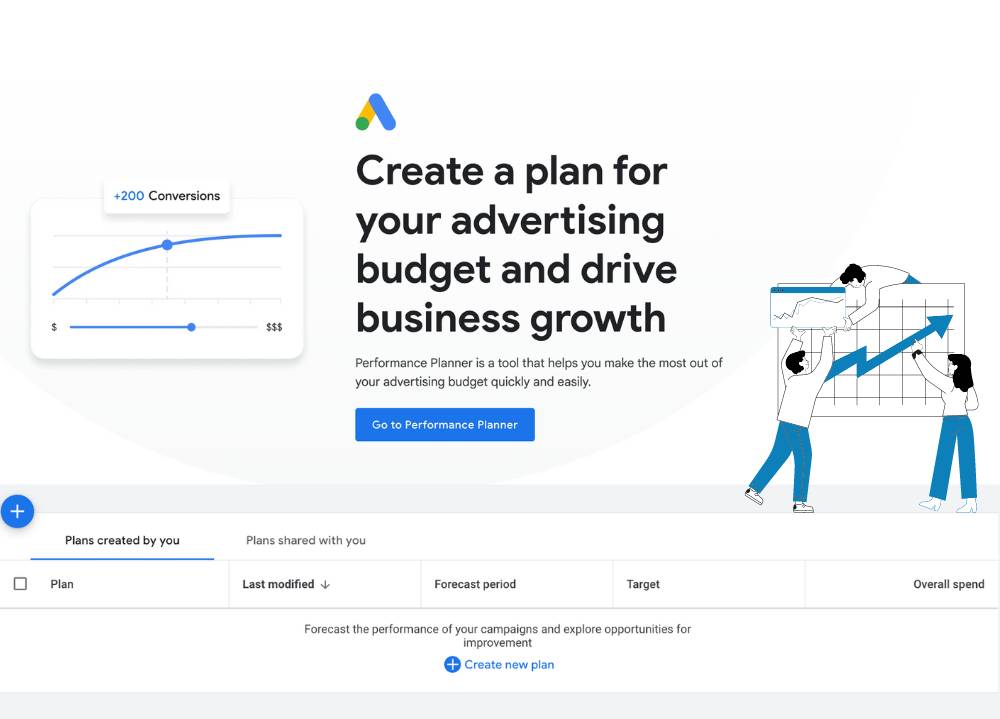Google’s Performance Planner is a tool designed to help advertisers forecast and optimize the performance of their Google Ads campaigns, ensuring that every dollar spent is an investment towards achieving their business goals. In this guide, we'll dive into how you can leverage Google's Performance Planner to not only predict but also enhance the outcomes of their ad campaigns.
Understanding Google's Performance Planner
At its core, the Performance Planner is a forecasting tool embedded within the Google Ads dashboard. It allows advertisers to create plans for their ad spend and visualize how modifications to campaigns could impact key performance metrics and overall campaign effectiveness. This tool is helpful in addressing questions like: "How will my campaigns perform if I adjust the advertising spend?" or "What strategies can I use to maximize conversions while adhering to my target Cost Per Acquisition (CPA)?"
The Performance Planner is key in planning for future advertising periods, predicting peak bids, and optimizing budgets. This ensures growth within Google Ads campaigns while maintaining a target Return on Investment (ROI).
Step-by-Step Guide to Using Performance Planner
To start optimizing your ad campaigns with the Performance Planner, follow these steps:
- 1. Navigate to "Tools and Settings" within your Google Ads account.
- 2. Under “Planning” select "Performance Planner" and click the "+" button to initiate a new plan.
- 3. Choose the campaigns you wish to include in your plan, ideally selecting those aligned with the same goals.
- 4. Set a future date range for your plan and select a key metric to forecast and optimize for, such as clicks, conversions, or conversion value.
- 5. Click "Create a plan" to view your forecast graph, where the gray dot represents your current campaign performance and the blue dot signifies the forecasted performance with your plan settings.
- 6. Use the "Improve plan" option for recommendations on optimal bid and budget adjustments.
- 7. Explore different spend scenarios on the graph to understand potential performance impacts.
The Performance Planner leverages billions of search queries and accounts for seasonality, competitor activity, and uses machine learning to enhance the accuracy of its forecasts.
Why Use Google's Performance Planner?
Predict Campaign Performance
One of the key benefits of using the Performance Planner is its ability to predict campaign performance before making any significant updates. This foresight allows businesses to make informed decisions, reducing the guesswork and risks associated with adjusting campaigns.
Maximize Budget Efficiency
The tool provides detailed insights on how to allocate the advertising budget more effectively. By offering tailored recommendations on bid and budget adjustments, it helps businesses achieve their marketing objectives without unnecessary expenditure.
Stay Ahead of Seasonal Trends
With the Performance Planner's ability to factor in seasonal trends and competitor activity, businesses can tailor their strategies to capitalize on these variations, ensuring they remain competitive throughout the year.
Continuous Optimization
As the tool uses machine learning, the accuracy of its forecasts improves over time. This continuous optimization ensures that businesses can adjust their strategies based on reliable data, leading to better performance and ROI.
Requirements of Google's Performance Planner
The Performance Planner has specific requirements that vary based on the type of Pay-Per-Click (PPC) ad campaigns you're running. The tool is designed to provide the most accurate forecasts for campaigns that have a history of performance data. Here's a breakdown of requirements by campaign type:
Search campaigns
- Must utilize Manual Cost-Per-Click (CPC), Enhanced CPC, Max Clicks, Max Conversions, Target Cost-Per-Action (CPA), or Target Return on Ad Spend (ROAS) bidding strategies.
- Must have been running for at least 72 hours.
- Must have received at least one conversion in the last seven days (if the campaign is conversion-focused).
- Must have received at least three clicks in the last seven days.
Shopping campaigns
- Must have achieved at least 100 conversions and/or conversion values within the past seven days.
- Must be active each day with a minimum spend of $10 in the last 10 days.
- Must have received at least 10 conversions/conversion values within the last 10 days.
- Must not have been limited by budget on any day in the last 10 days (applies only to Target ROAS standard shopping campaigns).
Display campaigns
- Must not have changed bid strategies in the past seven days.
- Must have been running for seven days or more.
- Must not have been recently budget-constrained.
- Must have secured at least five conversions.
These requirements ensure that the Performance Planner has enough historical data to make accurate predictions about your campaign's performance. The tool relies on past performance as a foundation for forecasting future outcomes, making it essential for campaigns to have a quantifiable track record for the planner to analyze.
Implementing Your Plan
After creating your plan with the Performance Planner, it's crucial to implement the recommended changes to see the benefits. Download the plan and upload it via Google Ads Editor to apply the adjustments to your campaigns.
By incorporating Google's Performance Planner into your advertising strategy, you can ensure that your ad spend is optimized for the best possible outcomes. Whether you're looking to enhance campaign performance, maximize budget efficiency, or navigate seasonal market changes, the Performance Planner provides the insights and recommendations needed to achieve your advertising objectives.
For further insights into Google Ads strategy, execution, and optimization, contact Titicus today to speak with our experts. Embrace the power of data-driven advertising with Google's Performance Planner and watch your campaigns thrive like never before.





